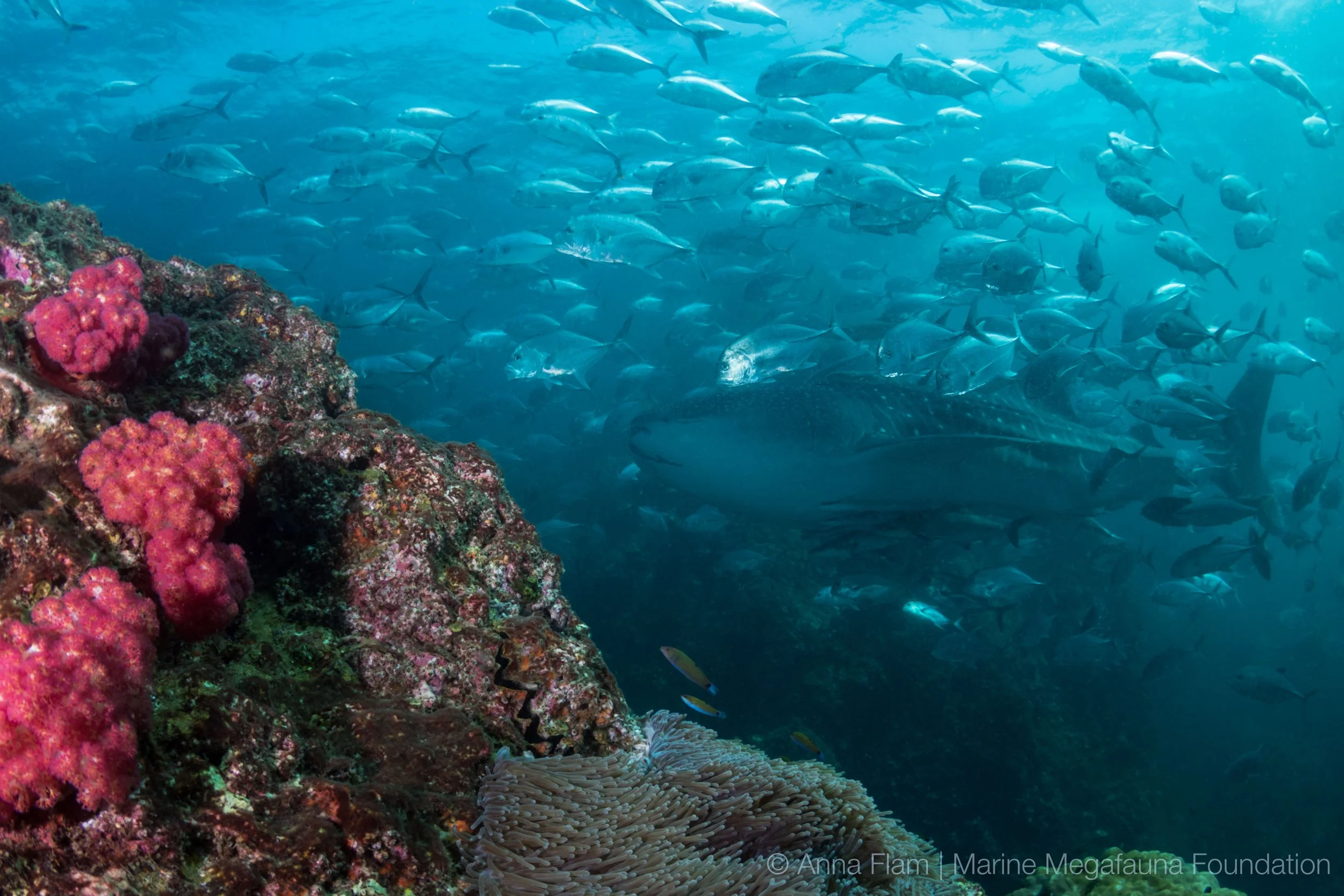MMF Helps Shape Seven New Important Shark and Ray Areas in Myanmar & Thailand
A giant manta swims over reef at Black Rock, Myanmar. Photo by Anna Flam
The Marine Megafauna Foundation (MMF) continues to play a key role in identifying globally significant critical marine habitats. Through long-term data collection and analysis in Myanmar and Thailand, MMF contributed to proposals for establishing seven new IUCN Important Shark & Ray Areas (ISRAs).
A whale shark swims through a school of trevally, Richelieu Rock in Thailand. Photo by Anna Flam
This designation process acknowledges the ecological importance of these areas and lays the groundwork for improved conservation efforts. Through the ISRA e-Atlas, a dynamic and user-friendly tool, governments, conservationists, and communities are empowered to make well-informed decisions, promoting the safeguarding of endangered marine species and their essential habitats.
Long-term research secures ISRA’s for key habitats
MMF's long-term research has been crucial in establishing the below seven ISRAs in Myanmar and Thailand:
Black Rock and the Twins View PDF
Burma Banks View PDF
Eight Mile Rock View PDF
Hin Muang & Hin Daeng View PDF
Koh Tao View PDF
Phi Phi Islands View PDF
Similan-Surin Archipelago View PDF
“By combining citizen science observations from scuba divers with data gathered during our research expeditions in Myanmar, we were able to identify key areas for species like giant mantas, whale sharks, and leopard sharks,” says Anna Flam, who leads MMF’s Myanmar and Thailand research. “For example, manta and whale shark sightings from citizen scientists helped us document over 200 giant mantas in Myanmar and a staggering 450 in Thailand. These data played a crucial role in designating Black Rock and the Twins, Hin Muang & Hin Daeng, and the Similan-Surin Archipelago as critical aggregation sites for giant mantas."
IUCN’s Marine e-Atlas shows the Important Shark and Ray Areas (ISRA) in red.
A possible blueprint for population recovery
The Phi Phi Islands ISRA offers a powerful lesson in marine conservation. While leopard shark populations have unfortunately declined over the past 15 years, highlighting the need for swift action, blacktip reef shark populations have shown a remarkable comeback. Targeted management changes within the Phi Phi ISRA appear to be responsible for this success. Researchers are now observing successful reproduction and even a functioning nursery for these blacktip reef sharks. This serves as a blueprint for hope.
Flam says “With these new ISRAs designated, it creates a fantastic opportunity to see the Phi Phi Islands' success story replicated for endangered species like the leopard shark. By implementing similar targeted conservation strategies in these areas, they have the potential to become sanctuaries for a variety of threatened species.”
Leopard shark with diver. Photo by Anna Flam
Conservation through collaboration
The compilation and analysis of many years of data from these sites was a massive team effort, with additional contributions from Myanmar Ocean Project, Thai Sharks and Rays, Thai Whale Shark, Spot the Leopard Shark, University of Queensland, University of the Sunshine Coast, eOceans, the Thailand Department of Fisheries, Chulalongkorn University, WildAid Thailand, Thailand Department of Marine and Coastal Resources, and CORDIO East Africa. Data from MantaMatcher.org, Sharkbook.ai also played a key role in the designation of these ISRAs.
Nurse sharks rests on the sandy bottom at Burma Banks, Thailand. Nurse sharks are the central species for the Burma Banks ISRA designation. Photo by Anna Flam
ISRAs: A foundation for focused conservation efforts
The creation of Important Shark and Ray Areas (ISRAs) in Asian waters serves as a crucial foundation for focused conservation endeavors. These areas are chosen through thorough scientific analysis, prioritizing sites with significant biodiversity of sharks, rays, and chimaeras, while also considering their importance for breeding, feeding, or other critical aspects of their life cycle.
Giant manta swims over reef at Black Rock, Myanmar. Photo by Anna Flam
About The Marine Megafauna Foundation
The Marine Megafauna Foundation (MMF) is a non-profit conservation organization based in Palm Beach, Florida. Founded in 2009, MMF is dedicated to the research and protection of threatened marine megafauna, focusing on large marine species like sharks, rays, and sea turtles, often referred to as 'megafauna'. Their mission is to ensure these majestic creatures thrive in harmony with humans. With a global reach, MMF works to understand these species' intricacies and the threats they face. Discover more at www.marinemegafauna.org
About ISRA (Important Shark and Ray Areas):
ISRA, an initiative by the International Union for Conservation of Nature (IUCN), plays a critical role in the conservation of shark and ray species worldwide. These designated areas are identified based on their ecological significance as key habitats for sharks and rays, often marking breeding grounds, feeding areas, or migration routes. The ISRA program aims to highlight these essential zones to guide global and local conservation efforts, including the implementation of Marine Protected Areas (MPAs). By focusing on these vital regions, ISRA seeks to ensure the long-term survival and health of these crucial marine species, contributing significantly to the broader goal of maintaining marine biodiversity and ecosystem balance.






